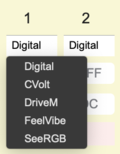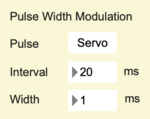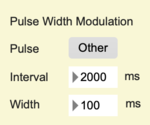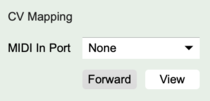EditorX-82 Actuator Outputs
The Actuator Outputs section configures the actuator outputs of the digitizer.
Contents
Availability
If the port is used by an I2C sensor, the menu of the actuator output with the same number is greyed out. Select one of the menu options to configure the port for actuator output (the corresponding sensor input widget will be greyed out and disabled instead).
Current/Reset
The actuator output section can display the currently active actuator output settings or the settings upon digitizer reset (eg. upon power-up of the digitizer). Click the button "Current" to switch to "Reset", and vice versa.
If the Current/Reset button is set to Current (white), the ON/OFF buttons set the current state. If the button is set to Reset (light blue color), the buttons and field below them set the status of the actuator outputs at power-up or after a software reset.
If the actuator output is configured to be controlled by a sensor input (see the input-output mapping section) or by MIDI Channel Voice messages (see below), the status is not updated to reflect the current status effectuated by the digitizer. However, if the actuator output status is not rapidly changing it's possible to use the "U" (Update) button to retrieve the current actuator output status.
Actuator Type
Three actuator types can be controlled by the digitizer. Actuators such as a relay or an LED are binary, ie. they have two states, and are controlled by applying 0 or 5V DC. Other actuators such as an RC servo are controlled by applying a regular recurring pulse of varying width, ie. pulse width modulation (PWM). The CVolt, DriveM, FeelVibe and SeeRGB actuators are controlled by using a synchronous serial digital protocol called I2C, which involves exchanging pulse trains that represent bytes between the sensor and the digitizer.
Binary DC Actuators
The outputs can be configured to output DC (direct current) voltages of 0 and 5V representing binary signals.
Select "Digital" from the menu for the output, set the DC/PWM button to "DC" and use the ON/OFF button to set the status.
The number field below the DC/PWM button sets the time delay in tenths of seconds (ie. the value 10 represents 1 second) until the ON or OFF status is switched following a threshold crossing. Zero means infinite, ie. the status is never switched. In the ON example below the delay is set to 0.2 seconds.
See also the SET OUTPUT, DUMP OUTPUT, the SET OUTPUT INIT, DUMP OUTPUT INIT commands.
PWM Actuators
The outputs can be configured to output pulse width modulated signals.
Select "Digital" from the menu for the output and use the DC/PWM button to enable PWM. The ON/OFF button now only sets the status that the actuator output should have after pulse width modulation is turned off.
The number field below the DC/PWM button sets the pulse width in milliseconds. In the example screenshots the pulse width is set to 1.120 milliseconds, while the Pulse Width Modulation section is set to the Servo default.
If the actuator output is configured to be controlled by a sensor input (see the input-output mapping section), the pulse width number field is not updated to reflect the current pulse width effectuated by the digitizer. However, if the actuator output status is not rapidly changing it's possible to use the Update button to retrieve the current actuator output status.
See also the SET OUTPUT, DUMP OUTPUT, the SET OUTPUT INIT, DUMP OUTPUT INIT commands.
The Pulse Width Modulation section sets the pulse interval and the pulse width range which only can be configured for all actuator outputs at the same time. Increasing the pulse width range to at least half the interval is useful for dimming an LED such as the SeeGreen actuator.
The Servo button restores the pulse interval and pulse width range to default settings (a 1-2 ms wide pulse with 20 ms interval) for use with RC servos. RC servos need to be powered separately in order to operate, eg. by using the 5V from a USB port via a USB cable. One of our AuxCable can be modified to provide the necessary wiring to connect to the WiDig, or a cable can be made using our HackPlugs.
See also the SET OUTPUT PULSE, DUMP OUTPUT PULSE commands.
I2C Actuators
The following I2C actuator presets are available:
CVolt
See the CVOLT function for more information.
DriveM
See the DRIVEM function for more information.
FeelVibe
See the FEELVIBE function for more information.
SeeRGB
See the SEERGB function for more information.
Select "CVolt, "DriveM", "FeelVibe" or "SeeRGB" from the actuator type menu to configure the actuator output. Use the top ON/OFF button to set the status.
To set the actuator method to use for the ON status, set the method to be used upon reset of the digitizer outputs (eg. at power-up). Switch to the Reset user interface and set the button labeled "TC" or "CC" to "CC" and set the number field below it to the desired value. The OFF status uses method zero. The ON status actuator method is retained in non-volatile memory even if switching back to "TC" after having set the actuator method to use for the ON status.
The button labeled "TC" or "CC" sets the output to use threshold control (TC), ie. trigger or toggle logic, or continuous control (CC), ie. direct or inverse translation.
If the button shows "CC", the number box below it sets the actuator method. In the CC example screen shot below the actuator method is set to 20, which represents an output voltage of approx. 5 * 20 / 127 = 0.79V.
If the button shows "TC" the number box below it sets the time delay in seconds until the ON or OFF status is switched following a threshold crossing. Zero means infinite, ie. the status is never switched. In the TC example screen shot below the delay is set to 2.5 seconds.
If the output is I-O mapped or CV MIDI mapped the displayed actuator method is not updated in the Current user interface to show the current method due to overriding sensor input or CV MIDI input. However, if the actuator output status is not rapidly changing it's possible to use the "U" update button to retrieve the current actuator output status.
See also the SET OUTPUT, DUMP OUTPUT, the SET OUTPUT INIT, DUMP OUTPUT INIT commands.
CV Mapping
The actuators can be controlled by sending Channel Voice (CV) MIDI messages (eg. Control Change MIDI messages) to the digitizer. The widget for this setting can be accessed from the I-O mapping section.
Such CV MIDI message mapped control of actuator outputs is implicitly configured through the selection of a MIDI message in the sensor configuration section. This configuration is then enabled when the I-O map for the corresponding sensor input is enabled.
Configure the MIDI device or software that sends the CV MIDI messages to send them directly to the MIDI port of the digitizer, or in the I-O Mapping section, select a MIDI port from which to receive the CV MIDI messages for the control of actuators. The forward button enables or disables the sending of the received MIDI messages to the digitizer that's connected to EditorX. The view button enables or disables display of the received MIDI messages in the corresponding sensor input monitor(s).











